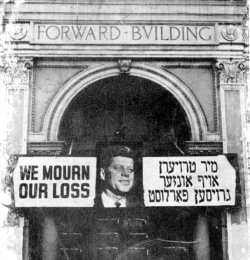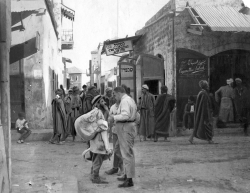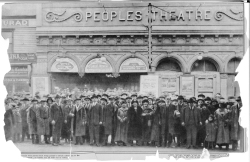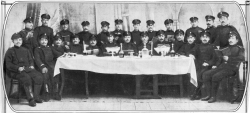For more than a century the lens of the Forward – originally known as the Yiddish-language daily newspaper Forvarts – has followed the journey of Jewish immigrants and their descendants into America, generating an eclectic group portrait of Jewish identity.
This month, the Forward celebrates its 110th anniversary with the publication of a volume of photos entitled A Living Lens: Photographs of Jewish Life from the Pages of the Forward (W. W. Norton, 2007) as well as a concurrent exhibition at the Museum of the City of New York featuring photographs and artifacts from the paper’s history.
Zeek spoke with the Forward‘s Arts & Culture Editor Alana Newhouse about preparing the paper’s visual history for publication in context of its evolving relationship with the Jewish community. As Newhouse explains, citing her editorial predescessor Jonathan Rosen, the paper has emerged from its intial focus on helping Jewish immigrants become Americans “to help a now-thoroughly Americanized community in its quest to understand, and engage with, its Jewish identity” in ways that – while at times unpredictable, unexpected, and hard to believe – very much parallel the Jewish-American story as a whole.
-David Stromberg, Book Reviews Editor  DS: How do you think these photos complement, but also contradict, the more linear history of Jews in the 20th century?
DS: How do you think these photos complement, but also contradict, the more linear history of Jews in the 20th century?
AN: The archive unveiled a much richer, more nuanced portrait of Jewish life than I imagined. The ‘more linear history of Jews in the 20th century,’ as you’ve termed it, highlights the banner headlines: immigration, the Holocaust, the founding of Israel, assimilation into American society. But the collection excavates the stories of millions of lived lives. It’s the totality of those experiences – snowball fights on Henry Street, union basketball teams, vaccines given out in the lobby of the Forward Building – that I found astonishing, mesmerizing, and exceptional.
DS: Do the different language editions of the Forward share images? Is there any editorial or photojournalistic overlap?
 AN: For shorthand sake, I’ll refer to the Yiddish edition as the Forverts, and the English one as the Forward. Technically speaking, the papers are run by separate staffs – two different sets of editors, writers and production people – each of which makes editorial and photojournalistic decisions independent of the other. Which makes it all the more impressive, I think, that we wind up reflecting each other a great deal. This might seem improbable, especially given the divergent make-ups of the staffs, but once you realize that the influence for both is the same – that is, Cahan’s pioneering vision – it begins to makes sense.
AN: For shorthand sake, I’ll refer to the Yiddish edition as the Forverts, and the English one as the Forward. Technically speaking, the papers are run by separate staffs – two different sets of editors, writers and production people – each of which makes editorial and photojournalistic decisions independent of the other. Which makes it all the more impressive, I think, that we wind up reflecting each other a great deal. This might seem improbable, especially given the divergent make-ups of the staffs, but once you realize that the influence for both is the same – that is, Cahan’s pioneering vision – it begins to makes sense.
As for your questions about sharing archives: When it comes to contemporary photojournalism, the two papers generally make separate choices – though if one or the other comes across something particularly special, we’re likely to alert our counterparts in the event that it might interest them as well. As for the historical, pre-1990 archives, those are obviously shared.
DS: Can you describe some of the effects you noticed throughout your editing of this collection on the ‘lens’ of this paper as it shifted from the view of an immigrant in a new land – as described in many books, including The Rise of David Levinsky, by the Forward’s founder Abraham Cahan – to one that is from inception part of the US?
AN: Here’s the truth, as revealed in those metal filing cabinets: The Forward was always an American paper. It may have taken its readers a while to realize their Americanness, and the country some time to recognize the diversity in its midst, but Cahan and his staff saw this as early as  1897. Remember, in many ways, one can’t describe the Forverts as simply a Jewish newspaper; although it certainly reported heavily on the Jewish community, it was, first and foremost, a purveyor of general-interest international and national news – in the language spoken by its audience.
1897. Remember, in many ways, one can’t describe the Forverts as simply a Jewish newspaper; although it certainly reported heavily on the Jewish community, it was, first and foremost, a purveyor of general-interest international and national news – in the language spoken by its audience.
There are certainly differences between Cahan’s Forverts and the English-language paper of today, but they flow not from having two wildly divergent missions, but rather from the nuance of an inverted one. It’s a brilliant analysis once offered by Jonathan Rosen, the founding editor of the Arts & Letters section: If the original mission of the Forverts was to help Eastern European Jews in their quest to become Americans, the mission of the Forward is to help a now-thoroughly Americanized community in its quest to understand, and engage with, its Jewish identity.
DS: The book features many faces, those of celebrities, politicians, and citizens of various Jewish communities. In piecing together these faces, was there an overall portrait that emerged? Can you describe this multi-faceted portrait?
 AN: It’s impossible, at least for me – but thankfully, the pictures here do a better job than I ever could. How do you describe a community at once enfeebled and emboldened, vibrant and challenged, adopting a new language and reinventing the old one? A community of celebrities and their audiences, union members and bosses, rabbis and rebels, gangsters and cops, doctors, lawyers, Texan oil titans, and Hadassah activists, YPSL kids and AEPi fraternity members, beauty queens and wrestlers, March of the Living participants and people who perform Bark Mitzvahs? This goes back to my answer to your first question. All of these individual experiences create the whole.
AN: It’s impossible, at least for me – but thankfully, the pictures here do a better job than I ever could. How do you describe a community at once enfeebled and emboldened, vibrant and challenged, adopting a new language and reinventing the old one? A community of celebrities and their audiences, union members and bosses, rabbis and rebels, gangsters and cops, doctors, lawyers, Texan oil titans, and Hadassah activists, YPSL kids and AEPi fraternity members, beauty queens and wrestlers, March of the Living participants and people who perform Bark Mitzvahs? This goes back to my answer to your first question. All of these individual experiences create the whole.
DS: Having researched the changing appearance of Jewish communities and lives as portrayed in the Forward, can to speak to the changes you noticed there? Do you see a wide gap between photos from the paper’s beginning and more recent ones? Or do you find only changes in ‘decoration,’ with an essentiality that is not so different?
 AN: Ah, well, the decoration changes year to year. In fact, the essentiality is the diversity. Many American Jews, especially those of us on the younger side, like to think that we invented the anti-establishment, DIY posture toward Jewish identity, but we absolutely did not. There have always been choices, a plethora of ways of expressing one’s Jewishness – from religious observance to politics to career choices. This remains true, even if cantors and seamstresses have given way to lawyers and doctors, if the messages on our protest banners have changed, if Molly Picon has yielded the stage to…Sarah Silverman.
AN: Ah, well, the decoration changes year to year. In fact, the essentiality is the diversity. Many American Jews, especially those of us on the younger side, like to think that we invented the anti-establishment, DIY posture toward Jewish identity, but we absolutely did not. There have always been choices, a plethora of ways of expressing one’s Jewishness – from religious observance to politics to career choices. This remains true, even if cantors and seamstresses have given way to lawyers and doctors, if the messages on our protest banners have changed, if Molly Picon has yielded the stage to…Sarah Silverman.
DS: Was there anything from your experience with Jewish life and history that you found surprising while looking through the Forward archives? Was there anything you found missing? Something presented differently than in other historical or periodical sources?
AN: I was most struck by the post-Holocaust era, and the evident trauma that the paper and its readers were undergoing. We missed some major stories – for example, in the arts, Philip Roth, Barbara Streisand, and Woody Allen all made appearances in the pages, but were not covered with nearly the kind of attention one might expect, given the status they hold as icons of American Jewish life. In 1951, Louis Finkelstein was featured on the cover of Time magazine, as evidence of the rebirth of religion in the suburbs – another development we didn’t quite catch. Then again, our pages were filled with ads for survivors looking for lost relatives – arguably a more powerful ‘story.’ We may not have caught every passing trend in the postwar years, but I believe we helped individuals, and the community at large, in the aftermath of unspeakable tragedy. That may not be fashionable by the standards of objective journalism, but it befits our role as a ‘member of the family.’








almost everyone in our family have hypertension, this disease is very common among older people“
Hello there! Good post! Please inform us when I will see a follow up!
Great write-up, I am regular visitor of one’s blog, maintain up the excellent operate, and It is going to be a regular visitor for a long time.
Can I merely say exactly what a relief to find a person that really knows what theyre discussing on-line. You definitely know how to bring an issue to light and earn it critical. More people need to read this and see why side on the story. I cant think youre not more well-known since you absolutely possess the gift.
Great post right here. One thing I’d like to say is that often most professional areas consider the Bachelor Degree like thejust like the entry level standard for an online degree. Whilst Associate Certification are a great way to begin, completing your own Bachelors uncovers many opportunities to various employment opportunities, there are numerous online Bachelor Diploma Programs available coming from institutions like The University of Phoenix, Intercontinental University Online and Kaplan. Another concern is that many brick and mortar institutions give Online variations of their college diplomas but commonly for a greatly higher payment than the companies that specialize in online higher education degree plans.
I discovered your blog site internet site on the internet and appearance some of your early posts. Continue to keep in the great operate. I just now additional increase your Rss to my MSN News Reader. Seeking toward reading far more from you finding out at a later date!…
you have a wonderful blog here! do you want to make some invite posts in this little weblog?